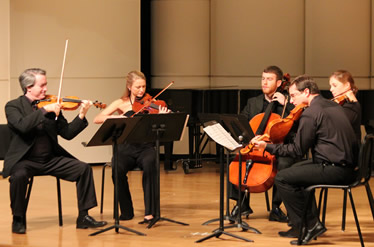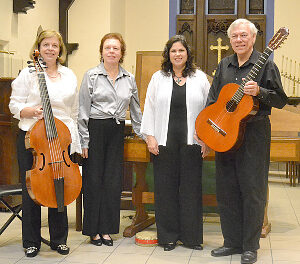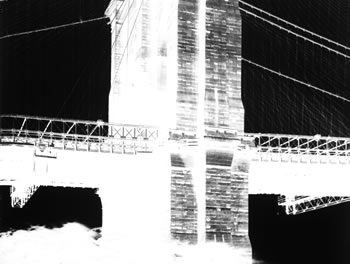When you think about it, it’s pretty amazing that there’s a living, breathing composer at NCSU, creating new music and presenting it there – and drawing substantial crowds to hear it. Come to think of it, there are now two composers at NCSU, and both are active in their fields. The first one is Rodney Waschka II, who runs the Arts NOW series, offering programs of new – often brand new – music. The second is J. Mark Scearce, recently-appointed Director of Music at NCSU. What makes this so amazing – to old faculty brats like this writer, who has been hanging around the Raleigh campus for over 50 years – is that the public perception of NCSU, or NC State, or Cow College, is that it’s a bastion of agriculture and engineering, devoid of the kinds of culture that make Chapel Hill and the Great Gothic Rockpile (a.k.a. Duke) so attractive to arts enthusiasts. ‘T ain’t completely true. Among other things, NCSU was for many years the home of the largest college-university concert series of its kind in the country, one that offered world-class artists and ensembles at ridiculously low prices (“7 concerts for $7” was its long-time mantra). And no other regional institution of higher learning presents two orchestras in regular series – the Raleigh Civic Symphony and the Raleigh Civic Chamber Orchestra are both led by Randolph Foy, whose commitment to new music is, like Waschka’s and Scearce’s, a matter of record.
So it should have come as no surprise that the Ballroom of NCSU’s Student Center was pleasantly full for the first Arts NOW concert of the season, presented on September 21, an evening when music lovers had several choices in the capital. And the Arts NOW concert was unusual in several respects. It was meant for kids – of all ages. There was an imported guest – composer Marc Satterwhite, of the University of Louisville. There were three world premieres – works by Satterwhite and Waschka and Karen Moorman, who “curated” the program. A flock of guest artists were on hand – members of the Mallarmé Chamber Players, outstanding Carrboro-based pianist Greg McCallum, and an ensemble of mostly young people. Atypically, there was not much electronic music or computer-generated (or computer-assisted) music, although there was some. Since youngsters were involved, the program began at 7:00 p.m., and that, in turn, allowed one to beat feet down Hillsborough Street to hear part of the evening’s other big attraction, a recital at St. Mary’s (reviewed elsewhere in CVNC). The oldest piece dated from 1969, which – to state the obvious – means that everything else was newer. The responses of the crowd were heartwarming – and demonstrated once again that conservative marketing gurus who think the only stuff worth hearing stemmed from the 19th century or earlier may be missing the boat.
The concert began and ended with works by Satterwhite, a fascinating composer whose short bio barely skims the surface of his activities and contributions to music. That said, the pieces offered may not reflect the genuine article, because both are based on other, earlier music. The first, “Seven Folksongs,” performed by oboist Bo Newsome and pianist McCallum, uses the themes of six well-known songs and one from Satterwhite’s formative years in a short set that suggested the many similar works of William Grant Still. Newsome is one of our finest players, and McCallum is one of our most distinguished and innovative pianists, so the performance had a great deal going for it.
Next up was Robert Erickson’s “Pacific Sirens” (1969), a work for recorded sounds – from the Pacific Ocean, then modified in the studio – and a flexible ensemble of strings, flute, clarinet, and percussion. The players hailed from the community and NCSU and from various middle and high schools – Githens and Turrentine Middle, the Durham School of the Arts, and Enloe, Athens Drive and Chapel Hill High; they were violinists Gabriela Arredondo, Chardonnay Johnson, Amy Levine, Jasmin Oates, and Carla Salvo-Lewis, violist Andre Kurepa Waschka, bassist Mike Kellum, flutist Ashley Molin, bass clarinetist Janice Lipson, and timpanist/percussionist Elena Albrect. Satterwhite beat time in this timeless, bar-less piece, which beat out the current crop of minimalists by years and years. The performance – no two can ever be quite the same – was effective and warmly received by the audience, the ranks of which included many members of the artists’ families.
Moorman, who is going for her MA in Liberal Studies, and who counts violinist Richard Luby and composer Roger Hannay among her mentors, presented “Mother Give Me,” a new work for electric violin, played by Amy Levine, and recorded electronic and altered sounds. The “poem” is by Elizabeth Levine, mother of the soloist. Some words were distinguishable, and among the components was a cell phone, which is a way to one-up the intrusions they often make during concerts. The piece was a bit of a kitchen-sink thing, with perhaps too many variants, but it fascinated in its own right, and the presence of a live player kept the audience on the edges of their seats.
Waschka’s “Good Luck and Bad Luck,” written for the artists who premiered it on this occasion, is a children’s tale about two brothers and the various forms of luck that plague them. Flutist Anna Ludwig Wilson, AD of the MCP, joined Newsome and McCallum for the performance, which involved some tapping and slapping of the piano, and a good bit of charming narration, which helped the tale unfold. Like many of the best fairy tales, there’s a lot in this that can – and did – appeal to adults, beyond the actual words. Some of the music, including several duets for the wind instruments, is very effective, so it might work as pure music, shorn of the story.
Beatriz Ferreyra’s “La Ba-Belle a Chien-chien a la Me-Mere” (2001) was the evening’s only nod to the sort of music that has made Arts NOW and Waschka famous – recorded electronic computer music, heard au naturel . The sound rattled around the ballroom, emanating from the speakers that ringed the walls. It, too, has a story line, dealing with (the program notes revealed) “a ball, a dog and a grandmother… in the countryside, between sunshine and a storm.” I am not sure I’d have known that without the crib, but it worked well enough, and it gave a foretaste of other works that will surely come on future programs in this series.
Satterwhite’s “Cantigas” was composed for this concert and played by Wilson (flute, piccolo, and tambourine), Newsome (oboe and English horn), and McCallum. It is based on “medieval monophonic songs from the Iberian Peninsula” that fans of the late-lamented Fortuna ensemble or collectors of various early-music recordings – especially those devoted to the Cantigas de Santa Maria – would have found vaguely familiar. The updatings in Satterwhite’s adaptations respect the originals while presenting the themes in modern dress. Mainliners reading this review should know that there was nothing off-putting in the music, which struck this listener as exceptionally beautiful.
The evening was enhanced by remarks from all three composers whose works were premiered, and the printed program included extensive notes on most of the pieces along with bios of the artists. Earlier in the day, Satterwhite had given a talk on his visit here. His visit was in every respect a class act. The next Arts NOW concert is planned for 10/19. Contributions to support the program may be made to the NC State Foundation, Inc. (tagged for “Arts Studies Development Fund”), and mailed to the Office of Development, College of Humanities and Social Sciences, Box 7011, Raleigh, NC 27695-7011.













